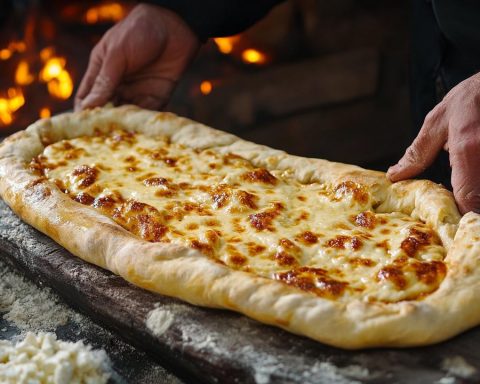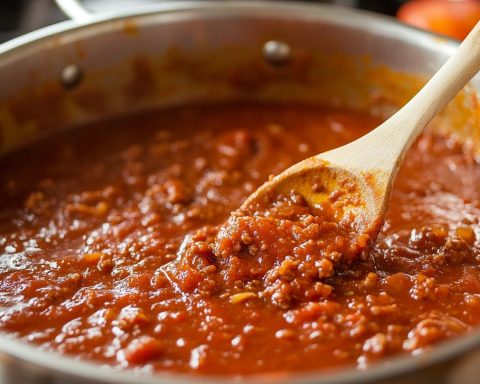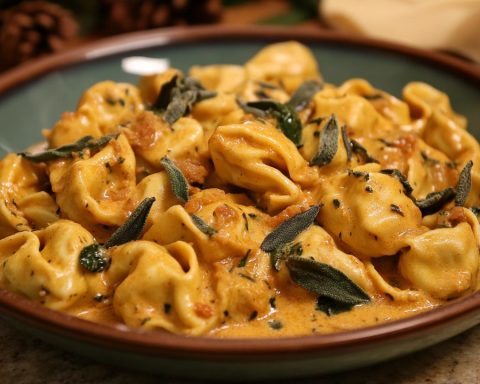Jambalaya, a vibrant and hearty dish hailing from the rich culinary tapestry of Louisiana, has become a beloved staple far beyond its Southern origins. Its roots can be traced back to the Creole and Cajun cooking traditions, where French and Spanish influences meld together in a harmonious blend of spices, meats, and seafood. Each spoonful of this enticing medley promises a journey through tangy tomato bases, the earthy sweetness of bell peppers, and a tapestry of aromatic spices.
A splendid choice for family gatherings, festive occasions, or a simple cozy night in, jambalaya is as versatile as it is delicious. This dish not only warms the soul but also embodies the spirit of sharing and celebration, often enjoyed with a side of crusty French bread or a light green salad.
Ingredients:
– 2 tablespoons olive oil
– 1 pound smoked sausage (such as Andouille or Kielbasa), sliced
– 1 pound chicken breasts, diced
– 1 large onion, diced
– 1 green bell pepper, chopped
– 2 celery stalks, diced
– 4 cloves of garlic, minced
– 1 can (14.5 ounces) crushed tomatoes
– 4 cups chicken broth
– 2 cups long grain rice
– 1 teaspoon paprika
– 1 teaspoon dried thyme
– 1 teaspoon oregano
– 1/2 teaspoon cayenne pepper (adjust to taste)
– 2 bay leaves
– Salt and pepper to taste
– 1 pound shrimp, peeled and deveined
– 2 green onions, sliced
– Fresh parsley, chopped for garnish
– Optional: Splash of hot sauce for added heat
Instructions:
1. In a large heavy-bottom pot or Dutch oven, heat the olive oil over medium-high heat. Add the smoked sausage and cook until lightly browned, about 5 minutes. Remove the sausage with a slotted spoon and set aside.
2. In the same pot, add the diced chicken. Cook until browned on all sides, about 6-7 minutes. Remove and set aside with the sausage.
3. Lower the heat to medium and add the onion, bell pepper, and celery. Sauté until the onions are translucent, about 5 minutes. Stir in the garlic and cook until fragrant, about 1 minute.
4. Pour in the crushed tomatoes and chicken broth. Stir to combine and bring to a simmer.
5. Add the rice, paprika, thyme, oregano, cayenne pepper, and bay leaves. Season with salt and pepper. Return the sausage and chicken to the pot, stirring well.
6. Cover the pot and reduce the heat to low. Let simmer until the rice is cooked and has absorbed the liquid, about 20-25 minutes. Stir occasionally to prevent sticking.
7. Add the shrimp to the pot, stirring into the mixture. Cover and cook until the shrimp are pink and cooked through, about 5 more minutes.
8. Remove from heat. Discard the bay leaves. Stir in green onions.
9. Garnish with fresh parsley. Serve hot, with a splash of hot sauce, if desired, and pair with some crusty French bread or a green salad.
Cooking Tips:
– Adjust the level of cayenne pepper and hot sauce to match your preferred spice level.
– Use high-quality rice to ensure the grains stay fluffy and separate.
– Try a mix of seafood like mussels or crab for an elevated touch.
Serving Suggestions:
– For an authentic Southern experience, serve with a chilled glass of sweet tea or a light beer.
– Add a side of corn on the cob seasoned with Creole spices to complement the meal.
Embrace the comfort and community of a well-made jambalaya—a dish that’s sure to delight with its complex layers of flavor and satisfy even the heartiest of appetites.
The Secret Stories and Surprises Behind Jambalaya
Jambalaya’s Hidden Gems and Controversies: While jambalaya is celebrated for its mouthwatering blend of spices and hearty ingredients, there are some intriguing factoids and debates that might surprise even the most seasoned enthusiasts. One lesser-known element is its culinary cousin, the Spanish paella. Both dishes share a similar base, yet purists argue whether tomatoes should even feature in jambalaya. While Creole-style embraces tomatoes, Cajun purists prefer a brown roux base, reflecting a significant cultural culinary divide.
Versatile Varieties and Unique Additions: Did you know that some cooks have started experimenting with jambalaya by introducing non-traditional ingredients like saffron and even bourbon for a unique twist on the classic recipe? For a vegetarian spin, some opt to replace the protein with mushrooms or jackfruit, maintaining the dish’s rich texture and flavor.
Why Is It Called Jambalaya? Another mystery that spices up jambalaya’s history is its name origin. Some suggest the name stems from the Provençal word “jambalaia,” meaning mishmash, which is quite fitting given the dish’s medley of ingredients.
For those eager to explore this dish’s deeper culinary roots or discover other Southern classics, consider exploring Delish or Serious Eats for more engaging stories and recipes. Keep in mind, the endless variations and cultural nuances continue to make jambalaya a fascinating subject for any food lover’s palate.








